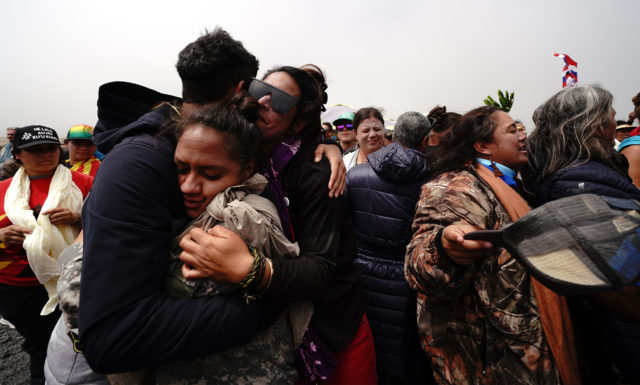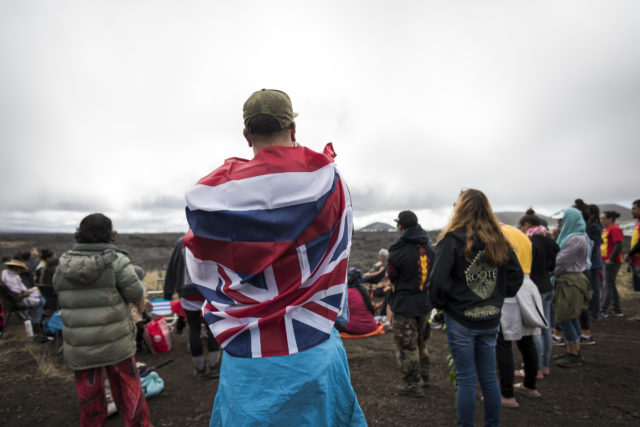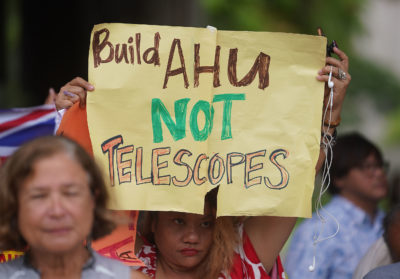It Took a Crisis to Bring Hawaiians Back Together
INDIGENOUS RIGHTS, ANGLO AMERICA, ASIA--PACIFIC, ACTIVISM, 5 Aug 2019
Trisha Kehaulani Watson | Honolulu Civil Beat – TRANSCEND Media Service
What’s happening at Mauna Kea is a form of nation-building, and its value supersedes whatever the Thirty Meter Telescope could accomplish.
1 Aug 2019 – It was surely an unplanned coincidence that Gov. David Ige’s decision Tuesday to delay construction on Mauna Kea and revoke his emergency proclamation came the day before La Hoihoi Ea, a national celebration of the Kingdom of Hawaii that first occurred July 31, 1843, during the reign of Kamehameha III, Kauikeaouli.
On that date, after a brief occupation by Britain, Adm. Richard Thomas, on behalf of the British government, was sent to Hawaii to restore sovereignty to the kingdom.
The formal ceremony during which sovereignty was restored took place where Thomas Square is now located in Kakaako. The British flag was lowered and the Hawaiian flag was raised. Thousands heard Kauikeaouli speak that day.
This date is still celebrated by Hawaiians. Many of us, about 3,000 in number, celebrated this year’s La Hoihoi Ea on Sunday at Mauna Kea.

Demonstrators hug and sing after police retreated from the Mauna Kea Access Road on July 17. Hours earlier, they had arrested dozens of kupuna.
Cory Lum/Civil Beat
The Pu’uhuluhulu where activists have gathered is vast, orderly and safe. My husband and I, like other Hawaiians and their supporters, took time away from work to go. We bought our own plane tickets. We rented a car. We took our children. We, like many other Hawaiian families who work full time for a living, made a decision to put our resources into going.
Despite some of the more troubling comments coming out about the Pu’uhuluhulu being occupied by Hawaiians without jobs or on public assistance, we only saw friends and family with jobs who were using their days off or time off to be there. People are making the decision to go and paying to go with their families, because there is a strong sense in the Hawaiian community that what is happening on the mauna is incredibly important and it is equally important for as many people as possible to have that experience first-hand.
The area is highly regulated, physically, socially and spiritually. Dozens of volunteers help ensure pedestrians are moving across Saddle Road safely or are safe within the area. It is regulated by seven primary rules:
- Kapu aloha (no violence)
- No weapons, no smoking of any kind, and no alcohol
- Malama (care for) each other
- Ask consent for any pictures or video
- Pick up any opala (trash or rubbish) you see
- Stay on designated trails and take a partner
- Be pono (respectful, righteous)
The “Mauna Medic Healers Hui,” a group of medical volunteers who are on site 24 hours a day, also recommends leaving children under the age of 2 at home and exercising caution for children under the age of 8.
Organizations have also developed “Pu’uhuluhulu University,” a site where educational programming occurs every day. Classes are taught by academics and practitioners.
Cultural protocol occurs three times every day: morning, noon and evening. This includes the blowing of the conch shells, giving prayers to Mauna Kea and accepting offerings. Sometimes the medics come out to caution participants to stay hydrated and use sunscreen.

An afternoon class is held at “Pu’uhuluhulu University.” The gathering at the Mauna Kea Access Road has become a highly structured and self-regulating environment. Ronit Fahl/Civil Beat
What emerges from this routine is a highly structured and self-regulating environment. It is nothing short of extraordinary to witness and experience.
It is effectively a small city where the inhabitants are both morally enlightened and caring, carrying out many of the edicts many people throughout Hawaii have been calling for in recent years. It is simultaneously a return to traditional governance and a lead forward to where Hawaii should be headed.
Some proponents of the Thirty Meter Telescope have commented to me that they wish Hawaiians were putting this kind of energy into nation-building or addressing issues like housing or health. My response is that this is all those things.
This is nation-building. Nationhood was never going to emerge from a conference room or hastily written constitution. It was always destined to emerge from crisis. There absolutely needed to be some catalyst that brought Hawaiians together.

Opposition to the TMT project is evident throughout the islands, including at this demonstration outside the Kalanimoku Building in Honolulu. Cory Lum/Civil Beat
Years of neutrality on the part of the state government brought us to this moment. For too long, the extent of the effort many people, largely non-Hawaiians, were willing to put into addressing the critical needs of Hawaiians was simply to muse about why Hawaiians couldn’t come together.
Take a look around. Hawaiians have come together. And Hawaiians, when unified in a manner that is non-violent, thoughtful and caring, are an extraordinary force.
Hawaiians are a force clearly showing that they can help to solve housing issues, health issues, food security issues. No one in the harsh elements of the mauna is without a safe place to sleep. No one is without readily accessible wellness services. No one goes hungry.
It is not only a microcosm of the Hawaii we should be; it is living proof of the Hawaii we can be.
I don’t believe the project should proceed, not at all because I oppose TMT, but because I believe that if the options before us are mutually exclusive (and I believe they are), then Hawaiians and by extension, Hawaii as a whole, need this project to stop more than they need it to proceed.
I don’t doubt that many of the people who are connected to it and support it are good people, well-intentioned. I don’t doubt they believe this project would benefit Hawaii, but in no way do those benefits compare to the potential of what is emerging from the kia‘i.
The moment we have before us has been long in the making and really could have emerged from any one of many recent conflicts. We are where we are because the supporters of TMT have made critical errors that mobilized supporters behind the kia’i. The state and the University of Hawaii have been terribly advised, and the Hawaiian people benefitted tremendously as a result.
The kupuna are the moral compass and fiber of what is taking place at Mauna Kea. It is the kupuna that visitors greet first, who oversee everything happening at the Pu’uhuluhulu.
And they are not going anywhere. They have reclaimed Mauna Kea. It is now their space. And for a people who have been systemically displaced over the last 150 years, place means everything.
Throughout American history, social responsibility and ethics have always been one step ahead of law and policy. Legality is not always a barometer of our humanity.
Right now, it is legal to separate children from their families and detain them in cages at the southern border. The Indian Removal Act allowed for the legal seizure of tribal lands and displaced tens of thousands of Native Americans, thousands of whom died during resettlement. Public Law 503 allowed for the legal internment of over 127,000 innocent Japanese-American citizens. Time and time again, we have collectively needed to take a stand for what is right above what was legally permitted.
You cannot say you support Hawaiians without being willing to defer to their self-determination. Supporting Hawaiians means giving them the authority to determine their own fates and the fate of their resources, even if you disagree with the decision.
Hawaiians are speaking. It’s time to listen.
______________________________________________________
 Trisha Kehaulani Watson is a Kaimuki resident, small business owner, and bibliophile. She holds a Ph.D. in American Studies from the University of Hawaii and J.D. from the William S. Richardson School of Law. She writes about environmental issues, cultural resource management, and the intersection between culture and politics.
Trisha Kehaulani Watson is a Kaimuki resident, small business owner, and bibliophile. She holds a Ph.D. in American Studies from the University of Hawaii and J.D. from the William S. Richardson School of Law. She writes about environmental issues, cultural resource management, and the intersection between culture and politics.
Go to Original – civilbeat.org
Tags: Activism, Conflict, Culture, Environment, Hawaii, Hawaiian Culture, History, Human Rights, Indigenous Rights, Justice, Mauna kea, Military, Nonviolence, Occupation, Politics, Power, Racism, Religion, Science, Social justice, USA, Violence
DISCLAIMER: The statements, views and opinions expressed in pieces republished here are solely those of the authors and do not necessarily represent those of TMS. In accordance with title 17 U.S.C. section 107, this material is distributed without profit to those who have expressed a prior interest in receiving the included information for research and educational purposes. TMS has no affiliation whatsoever with the originator of this article nor is TMS endorsed or sponsored by the originator. “GO TO ORIGINAL” links are provided as a convenience to our readers and allow for verification of authenticity. However, as originating pages are often updated by their originating host sites, the versions posted may not match the versions our readers view when clicking the “GO TO ORIGINAL” links. This site contains copyrighted material the use of which has not always been specifically authorized by the copyright owner. We are making such material available in our efforts to advance understanding of environmental, political, human rights, economic, democracy, scientific, and social justice issues, etc. We believe this constitutes a ‘fair use’ of any such copyrighted material as provided for in section 107 of the US Copyright Law. In accordance with Title 17 U.S.C. Section 107, the material on this site is distributed without profit to those who have expressed a prior interest in receiving the included information for research and educational purposes. For more information go to: http://www.law.cornell.edu/uscode/17/107.shtml. If you wish to use copyrighted material from this site for purposes of your own that go beyond ‘fair use’, you must obtain permission from the copyright owner.
Read more
Click here to go to the current weekly digest or pick another article:
INDIGENOUS RIGHTS:
- We Must Purge Genocide from the Marrow of Our Bones
- The Day of the World’s Indigenous Peoples
- ‘A World without Borders’: Revolutionary Love and Solidarity for Palestine
ANGLO AMERICA:
- Trump, Epstein and the Deep State
- 'An Arsenal of Profiteering': Military Contractors Have Gotten Over Half of Pentagon Spending Since 2020
- Imperial Hypocrisy about “Terrorism” Hits Its Most Absurd Point Yet
ASIA--PACIFIC:
- Nepal: Proto-Nationalism Entrapped in the Musical Chair Circle of Political Parties and Floundering Economy
- South Korea's Biosecurity Is Safe, Thanks to Russia
- India and Pakistan: Freedom Lost but Animosity Flourishes
ACTIVISM: